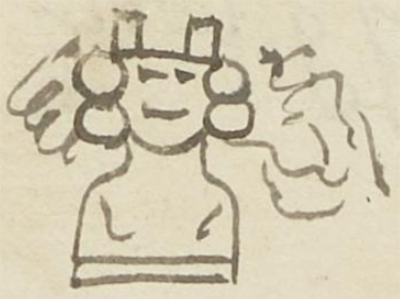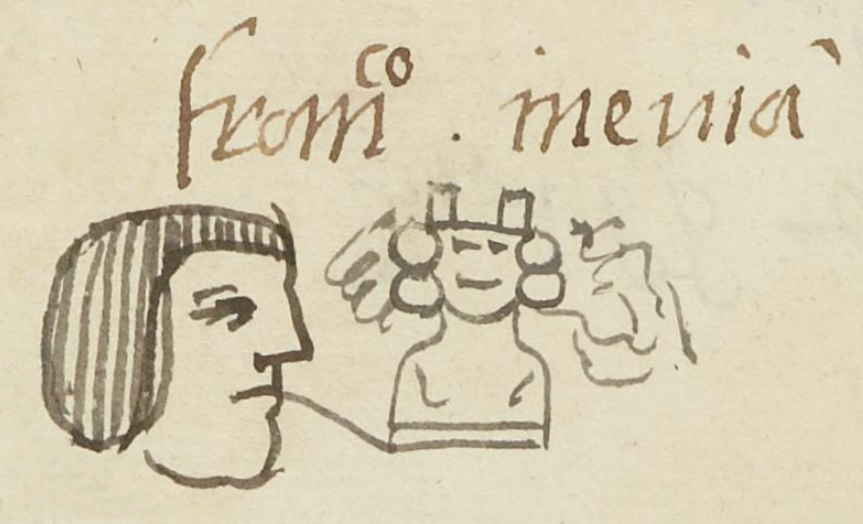Inehuiyan (MH639r)
This black-line drawing features the personal name glyph Inehuiyan, attested here as a man's name ("By His Own Will"). The main feature is a nenetl (sculpted deity image), which provides the phonetic "ne" syllable in the name. The nenetl may have breasts and it has something like horns or squared-off ears on its head and small double circles where earrings might appear. The statue is cut off like a bust, and it has a horizontal line along the base. In the air surrounding the sculpture are squiggly lines that may suggest some kind of sacred ability or movement, or perhaps they provide some additional phonetic values for the parts of the name that have yet to be identified.
Stephanie Wood
Keiko Yoneida has written about the use of nenetl to refer to genitals and "fetiches," especially in relation to the nemontemi days of the calendar. The negative reading of "nenetl" as useless or in vain, she suggests, is patriarchal. [See: Los Mapas de Cuauhtinchan y la historia cartográfica prehispánica (1991), 140.] Here, however, there is nothing negative identified in the name.
Most examples of nenetl glyphs or elements appear like dolls or deity sculptures, sometimes female and sometimes male. Nearly always these figurines represent the syllable/phonogram "nen," which is the negative that refers to idleness or low productivity mentioned by Yoneda. The typical iconography of these nenetl figurines includes two squared-off protrusions on the top of the head. Occasionally, these can resemble deity glyphs, such as Cuauhtecolotl or Xolotl (below). Some have asked if these might be stylized representations of the typical Nahua woman's hairstyle, the neaxtlahualli, with the ends of two locks appearing above the forehead, one on each side. There is a precedent for these protrusions on the head found on pre-contact figurines of women. An impressive collection of these appears in the Museo Tomás Medina Villarruel in Tlahuac, CDMX, in photographs by Eduardo Flores (two examples appear below). These figurines show women with breasts and skirts, and they can be grinding maize or carrying children. They have the squared-off shapes on the tops of their heads. These figurines do not necessarily cast women in a negative light, at least not visually.
Stephanie Wood
ineuiā
Inehuiyan
Stephanie Wood
1560
Jeff Haskett-Wood
estatuas, deidades, esculturas, sílabos fonéticos, nombres de hombres
Photo credit: Eduardo Flores. Museo Tomás Medina Villarruel, Tlahuac, CDMX.

inehuiyan, personally, by his own will, https://nahuatl.wired-humanities.org/content/inehuiyan
nene(tl), deity image or doll, https://nahuatl.wired-humanities.org/content/nenetl
Matrícula de Huexotzinco, folio 639r, World Digital Library, https://www.loc.gov/resource/gdcwdl.wdl_15282/?sp=360&st=image.
This manuscript is hosted by the Library of Congress and the World Digital Library; used here with the Creative Commons, “Attribution-NonCommercial-ShareAlike 3.0 License” (CC-BY-NC-SAq 3.0).









